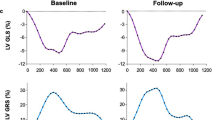Abstract
Objectives
To evaluate the feasibility of three-dimensional (3D) maximum principal strain (MP-strain) derived from cardiac computed tomography (CT) for detecting myocardial infarction (MI).
Methods
Forty-three patients who underwent cardiac CT and magnetic resonance imaging (MRI) were retrospectively selected. Using the voxel tracking of motion coherence algorithm, the peak CT MP-strain was measured using the 16-segment model. With the trans-mural extent of late gadolinium enhancement (LGE) and the distance from MI, all segments were classified into four groups (infarcted, border, adjacent, and remote segments); infarcted and border segments were defined as MI with LGE positive. Diagnostic performance of MP-strain for detecting MI was compared with per cent systolic wall thickening (%SWT) assessed by MRI using receiver-operating characteristic curve analysis at a segment level.
Results
Of 672 segments excluding16 segments influenced by artefacts, 193 were diagnosed as MI. Sensitivity and specificity of peak MP-strain to identify MI were 81 % [95 % confidence interval (95 % CI): 74-88 %] and 86 % (81-92 %) compared with %SWT: 76 % (60-95 %) and 68 % (48-84 %), respectively. The area under the curve of peak MP-strain was superior to %SWT [0.90 (0.87-0.93) vs. 0.80 (0.76-0.83), p < 0.05].
Conclusions
CT MP-strain has a potential to provide incremental value to coronary CT angiography for detecting MI.
Key Points
• CT MP-strain allows for three-dimensional assessment of regional cardiac function.
• CT-MP strain has high diagnostic accuracy for detecting myocardial infarction.
• CT-MP strain may assist in tissue characterisation of myocardium assessed by LGE-MRI.
• CT-MP strain provides incremental values to coronary CTA for detecting myocardial infarction.





Similar content being viewed by others
Abbreviations
- MI:
-
myocardial infarction
- LGE:
-
late gadolinium enhancement
- MRI:
-
magnetic resonance imaging
- 2D:
-
two-dimensional
- 3D:
-
three-dimensional
- MP-strain:
-
maximum principal strain
- CT:
-
computed tomography
- LV:
-
left ventricular
- CAD:
-
coronary artery disease
- CM:
-
contrast media
- ECG:
-
electrocardiogram
- %SWT:
-
per cent systolic wall thickening
- SD:
-
standard deviations
- ROC:
-
receiver-operating characteristic
- AUC:
-
area under the curve
- PPV:
-
positive predictive values
- NPV:
-
negative predictive values
References
Cheong BY, Muthupillai R, Wilson JM et al (2009) Prognostic significance of delayed-enhancement magnetic resonance imaging: survival of 857 patients with and without left ventricular dysfunction. Circulation 120:2069–2076
Larose E, Rodés-Cabau J, Pibarot P et al (2010) Predicting late myocardial recovery and outcomes in the early hours of ST-segment elevation myocardial infarction traditional measures compared with microvascular obstruction, salvaged myocardium, and necrosis characteristics by cardiovascular magnetic resonance. J Am Coll Cardiol 55:2459–2469
Pride YB, Piccirillo BJ, Gibson CM (2013) Prevalence, consequences, and implications for clinical trials of unrecognized myocardial infarction. Am J Cardiol 111:914–918
Leening MJ, Elias-Smale SE, Felix JF et al (2010) Unrecognised myocardial infarction and long-term risk of heart failure in the elderly: the Rotterdam Study. Heart 96:1458–1462
Kim RJ, Fieno DS, Parrish TB, Harris K, Chen EL, Simonetti O et al (1999) Relationship of MRI delayed contrast enhancement to irreversible injury, infarct age, and contractile function. Circulation 100:1992–2002
Huber S, Muthupillai R, Cheong B, Wible JH Jr, Shah D, Woodard P et al (2008) Safety of gadoversetamide in patients with acute and chronic myocardial infarction. J Magn Reson Imaging 28:1368–1378
Götte MJ, van Rossum AC, Twisk JWR, Kuijer JPA, Marcus JT, Visser CA (2001) Quantification of regional contractile function after infarction: strain analysis superior to wall thickening analysis in discriminating infarct from remote myocardium. J Am Coll Cardiol 37:808–817
Geyer H, Caracciolo G, Abe H et al (2010) Assessment of myocardial mechanics using speckle tracking echocardiography: fundamentals and clinical applications. J Am Soc Echocardiogr 23:351–369
Inoue Y, Yang X, Nagao M et al (2010) Peri-infarct dysfunction in post-myocardial infarction: assessment of 3-T tagged and late enhancement MRI. Eur Radiol 20:1139–1148
Nakamura M, Kido T, Kido T et al (2015) Quantitative circumferential strain analysis using adenosine triphosphate-stress/rest 3-T tagged magnetic resonance to evaluate regional contractile dysfunction in ischemic heart disease. Eur J Radiol 84:1493–1501
Kido T, Nagao M, Kido T et al (2013) Stress/rest circumferential strain in non-ischemia, ischemia, and infarction—quantification by 3 Tesla tagged magnetic resonance imaging. Circ J 77:1235–1241
Oyama-Manabe N, Ishimori N, Sugimori H et al (2011) Identification and further differentiation of subendocardial and transmural myocardial infarction by fast strain-encoded (SENC) magnetic resonance imaging at 3.0 Tesla. Eur Radiol 21:2362–2368
Croisille P, Moore CC, Judd RM et al (1999) Differentiation of viable and nonviable myocardium by the use of three-dimensional tagged MRI in 2-day-old reperfused canine infarcts. Circulation 99:284–291
Yamashina A, Ueshima K, Kimura K, Kuribayashi S, Sakuma H, Tamaki N et al (2009) Guideline for noninvasive diagnosis of coronary artery lesions. Circ J 73:1019–1089
Kawaguchi N, Kurata A, Kido T et al (2014) Optimization of coronary attenuation in coronary computed tomography angiography using diluted contrast material. Circ J 78:662–670
Wai B, Thai WE, Brown H, Truong QA (2013) Novel phase-based noise reduction strategy for quantification of left ventricular function and mass assessment by cardiac CT: comparison with cardiac magnetic resonance. Eur J Radiol 82:e337–e341
Masri A, Schoenhagen P, Svensson L et al (2014) Dynamic characterization of aortic annulus geometry and morphology with multimodality imaging: predictive value for aortic regurgitation after transcatheter aortic valve replacement. J Thorac Cardiovasc Surg 147:1847–1854
Cerqueira MD, Weissman NJ, Dilsizian V, American Heart Association Writing Group on Myocardial Segmentation and Registration for Cardiac Imaging et al (2002) Standardized myocardial segmentation and nomenclature for tomographic imaging of the heart. A statement for healthcare professionals from the Cardiac Imaging Committee of the Council on Clinical Cardiology of the American Heart Association. Circulation 105:539–542
Kido T, Kido T, Nakamura M et al (2014) Three-dimensional phase-sensitive inversion recovery sequencing in the evaluation of left ventricular myocardial scars in ischemic and non-ischemic cardiomyopathy: comparison to three-dimensional inversion recovery sequencing. Eur J Radiol 83:2159–2166
Wang R, Meinel FG, Schoepf UJ, Canstein C, Spearman JV, De Cecco CN (2015) Performance of automated software in the assessment of segmental left ventricular function in cardiac CT: comparison with cardiac magnetic resonance. Eur Radiol 25:3560–3566
Bondarenko O, Beek AM, Hofman MB (2005) Standardizing the definition of hyperenhancement in the quantitative assessment of infarct size and myocardial viability using delayed contrast-enhanced CMR. J Cardiovasc Magn Reson 7:481–485
Wong DT, Weightman MJ, Baumert M (2012) Electro-mechanical characteristics of myocardial infarction border zones and ventricular arrhythmic risk: novel insights from grid-tagged cardiac magnetic resonance imaging. Eur Radiol 22:1651–1658
Sternberg MR, Hadgu A (2001) A GEE approach to estimating sensitivity and specificity and coverage properties of the confidence intervals. Stat Med 20:1529–1539
Kumar R, Indrayan A (2011) Receiver operating characteristic (ROC) curve for medical researchers. Indian Pediatr 48:277–287
Karamitsos TD, Francis JM, Myerson S, Selvanayagam JB, Neubauer S (2009) The role of cardiovascular magnetic resonance imaging in heart failure. J Am Coll Cardiol 54:1407–1424
Konstam MA, Kramer DG, Patel AR, Maron MS, Udelson JE (2011) Left ventricular remodeling in heart failure: current concepts in clinical significance and assessment. JACC Cardiovasc Imaging 4:98–108
Del-Canto I, López-Lereu MP, Monmeneu JV et al (2015) Characterization of normal regional myocardial function by MRI cardiac tagging. J Magn Reson Imaging 41:83–92
Min JK, Shaw LJ, Berman DS (2010) The present state of coronary computed tomography angiography a process in evolution. J Am Coll Cardiol 55:957–965
Miller JM, Rochitte CE, Dewey M et al (2008) Diagnostic performance of coronary angiography by 64-row CT. N Engl J Med 359:2324–2336
Arsanjani R, Berman DS, Gransar H, CONFIRM Investigators et al (2014) Left ventricular function and volume with coronary CT angiography improves risk stratification and identification of patients at risk for incident mortality: results from 7758 patients in the prospective multinational CONFIRM observational cohort study. Radiology 273:70–77
Tavakoli V, Sahba N (2014) Cardiac motion and strain detection using 4D CT images: comparison with tagged MRI, and echocardiography. Int J Cardiovasc Imaging 30:175–184
Helle-Valle TM, Yu WC, Fernandes VR, Rosen BD, Lima JA (2010) Usefulness of radial strain mapping by multidetector computer tomography to quantify regional myocardial function in patients with healed myocardial infarction. Am J Cardiol 106:483–491
Tee MW, Won S, Raman FS et al (2015) Regional strain analysis with multidetector CT in a swine cardiomyopathy model: relationship to cardiac MR tagging and myocardial fibrosis. Radiology 277:88–94
Cheng A, Nguyen TC, Malinowski M, Daughters GT, Miller DC, Ingels NB Jr (2008) Heterogeneity of left ventricular wall thickening mechanisms. Circulation 118:713–721
Pilla JJ, Koomalsingh KJ, McGarvey JR et al (2015) Regional myocardial three-dimensional principal strains during postinfarction remodeling. Ann Thorac Surg 99:770–778
Ennis DB, Epstein FH, Kellman P, Fananapazir L, McVeigh ER, Arai AE (2003) Assessment of regional systolic and diastolic dysfunction in familial hypertrophic cardiomyopathy using MR tagging. Magn Reson Med 50:638–642
Buss SJ, Breuninger K, Lehrke S et al (2015) Assessment of myocardial deformation with cardiac magnetic resonance strain imaging improves risk stratification in patients with dilated cardiomyopathy. Eur Heart J Cardiovasc Imaging 16:307–315
Acknowledgement
We greatly appreciate Yasuhiro Kondo (Ziosoft Inc., Tokyo, Japan) for valuable technical comments. The scientific guarantor of this publication is Teruhito Mochizuki. The authors of this manuscript declare no relationships with any companies, whose products or services may be related to the subject matter of the article. Yasuhiro Kondo declares relationships with the following companies: Ziosoft Inc., Tokyo, Japan. The authors state that this work has not received any funding. One of the authors has significant statistical expertise. We also asked for a statistical review and advice for this manuscript from StaGen Co. Ltd. Institutional Review Board approval was obtained. Written informed consent was obtained from all subjects (patients) in this study. Methodology: retrospective, observational, performed at one institution.
Author information
Authors and Affiliations
Corresponding author
Electronic supplementary material
Below is the link to the electronic supplementary material.
ESM 1
(DOC 6800 kb)
Rights and permissions
About this article
Cite this article
Tanabe, Y., Kido, T., Kurata, A. et al. Three-dimensional maximum principal strain using cardiac computed tomography for identification of myocardial infarction. Eur Radiol 27, 1667–1675 (2017). https://doi.org/10.1007/s00330-016-4550-9
Received:
Revised:
Accepted:
Published:
Issue Date:
DOI: https://doi.org/10.1007/s00330-016-4550-9




